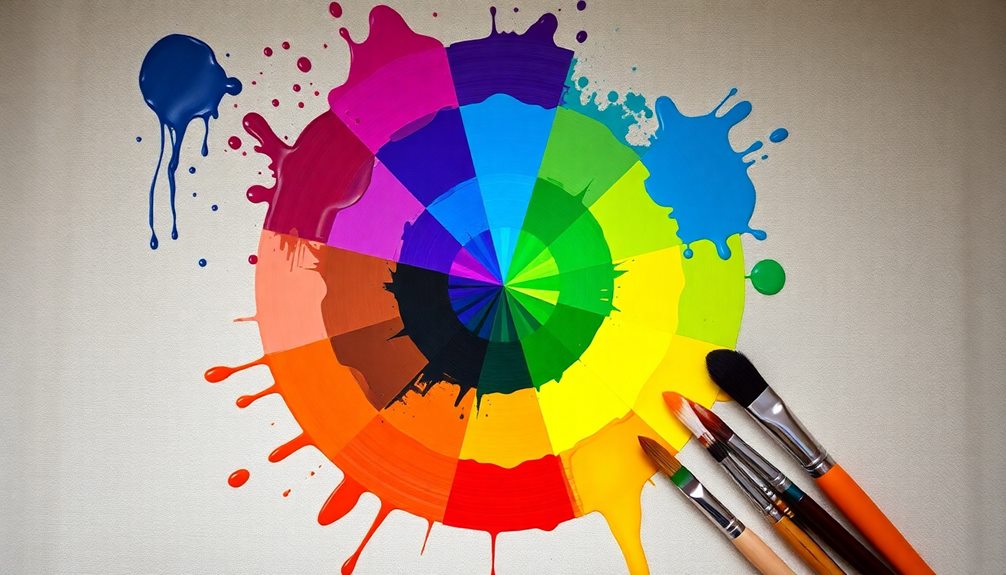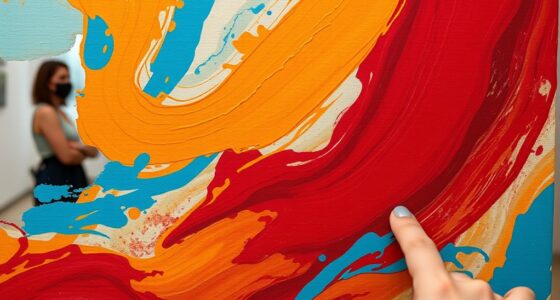When analyzing sculpture, focus on how material textures evoke emotions and set the mood. Notice how light creates shadows and highlights, revealing surface details and emotional nuances. Observe the sculpture’s placement and how it interacts with its surroundings, shaping your perception of space and form. Moving around the piece helps uncover new perspectives and details. Exploring these elements shows the artist’s intentions and deepens your appreciation—stick with us to uncover more about this fascinating art form.
Key Takeaways
- Examine material textures to understand the artist’s emotional intent and cultural influences.
- Assess how light interacts with surfaces to reveal shadows, highlights, and surface intricacies.
- Explore the sculpture from multiple angles to perceive form, spatial dynamics, and changing details.
- Consider the sculpture’s placement and relationship to surrounding space for contextual understanding.
- Analyze surface details, texture, and form to interpret underlying messages and artistic techniques.

Sculpture is a powerful art form that captures human creativity in three-dimensional space. When you approach a sculpture, you’re engaging with more than just its visual aesthetic—you’re exploring how material textures and spatial interaction come together to evoke emotion, meaning, and context. Material textures are fundamental to understanding a sculpture’s impact. Whether smooth marble, rough clay, or rugged metal, textures influence how you perceive a sculpture’s mood and message. A polished surface might suggest purity, refinement, or serenity, while a rough or uneven texture can evoke raw emotion or a sense of struggle. As you move around the sculpture, notice how light interacts with these textures, casting shadows or highlighting ridges and valleys. This play of light and shadow enhances your tactile perception, even if you’re not physically touching the piece. Texture invites you to imagine what it might feel like, engaging your senses beyond sight alone. Additionally, considering how the artist uses material choice can reveal insights into their intentions and cultural influences. Recognizing the importance of material textures can deepen your appreciation for the craftsmanship involved. Furthermore, understanding the historical context behind a sculpture can help you grasp its significance and the message it conveys. Incorporating knowledge of artistic techniques can also enrich your interpretation of the work’s execution and style. Spatial interaction is equally crucial in analyzing sculpture. Unlike two-dimensional art, sculptures occupy physical space, and your position relative to the work changes your experience. When you stand close, you might focus on intricate surface details or subtle textures, but stepping back allows you to appreciate its overall form and how it relates to its environment. Observe how the sculpture interacts with its surroundings—does it seem to extend outward, inviting you to walk around it? Does it create a sense of enclosure or openness? Spatial interaction also involves considering how the sculpture’s volume and proportions influence your perception. A sculpture with a commanding presence may seem to dominate the space, making you feel small or awed, while a more delicate piece might draw you in with intimacy. As you move around the sculpture, notice how its form shifts, how certain angles reveal new details, and how its placement influences your understanding of the work’s purpose. When analyzing sculpture, you should pay attention to these elements—material textures and spatial interaction—because they work together to deepen your comprehension. Texture impacts your tactile imagination and emotional response, while spatial interaction shapes your physical and psychological engagement. By actively observing how these aspects function, you access a richer appreciation of the artist’s intent and the sculpture’s role within its environment. Whether you’re studying a classical marble statue or a contemporary assemblage, recognizing how material textures and spatial dynamics operate helps you connect more profoundly with three-dimensional art. Ultimately, approaching sculpture with a mindful eye allows you to see beyond the surface, understanding how form, material, and space communicate in powerful, fascinating ways.
Frequently Asked Questions
How Do Different Materials Affect Sculpture Interpretation?
When you consider how different materials affect sculpture interpretation, you notice material symbolism plays a key role. For example, bronze suggests strength, while clay conveys fragility. Texture interpretation also impacts how viewers experience the piece; rough surfaces evoke raw emotion, whereas smooth ones feel calming. Your choice of materials guides viewers’ emotional response and understanding, making the sculpture’s message more vivid and meaningful through the interplay of symbolism and tactile qualities.
What Are Common Tools Used in Sculpture Analysis?
Think of sculpture analysis tools as your treasure map in a three-dimensional world. You’ll use sculpture terminology to describe forms, textures, and spatial relationships accurately. Analysis techniques like visual inspection, measuring, and comparing materials help reveal the artist’s intent and craftsmanship. These tools allow you to navigate the sculpture’s complexities, uncovering hidden meanings and appreciating the skill behind each curve and contour, making your interpretation richer and more precise.
How Does Context Influence the Meaning of a Sculpture?
When you consider how context influences a sculpture, you realize it shapes your understanding of its meaning. Cultural symbolism and historical significance play vital roles, revealing what the artwork represented at its creation and what it continues to signify today. By examining these aspects, you deepen your appreciation, recognizing that the sculpture’s purpose and message are tied closely to the time, place, and cultural beliefs surrounding it.
Can Digital Technology Enhance Sculpture Appreciation?
You might think digital tech ruins the tactile charm of sculpture, but it actually enhances appreciation. With virtual reality and augmented reality, you can explore sculptures in new ways—walking around, zooming in, or seeing them in different settings. Ironically, these innovations give you a closer, more immersive experience, making sculptures more accessible and engaging, even if you can’t physically touch them. Technology truly transforms how you connect with three-dimensional art.
What Are Emerging Trends in Contemporary Sculpture?
You see that emerging trends in contemporary sculpture involve innovative techniques like augmented reality and sustainable materials. Artists are blending traditional craftsmanship with digital tools, creating interactive pieces that engage viewers. Cultural symbolism also plays a significant role, as sculptures reflect diverse identities and societal issues. By exploring these trends, you can appreciate how artists push boundaries, making sculpture more dynamic, meaningful, and relevant to today’s world.
Conclusion
As you reflect on sculpture, remember that like Michelangelo’s David, every piece captures more than form—it embodies a story, a moment frozen in time. Your eye becomes a chisel, revealing depth beneath the surface, connecting you to the artist’s vision. By analyzing sculpture, you unearth a dialogue between space and substance, turning each observation into a journey of discovery. Ultimately, you participate in a timeless conversation, echoing the masters who shaped history with their hands.









